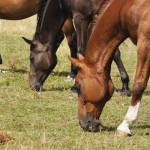Stocking Rate: How Many Horses on This Pasture?

Stocking rate is defined as the number of horses allowed to graze a unit of land for a specific amount of time. Making the most of pastures by optimizing stocking rate may reduce other forage expenditures. Stocking rate is contingent upon numerous factors including grazing behavior, level of pasture management, forage species, seasons, and weather patterns.
Before considering specific factors that dictate stocking rate, the grazing behavior of horses must be taken into account. Horses are notoriously destructive to pastures. Far more unforgiving on pasturelands than cattle, horses are selective grazers, preferring to rip short, immature vegetation close to the ground. In arid regions, horses may completely uproot plants. Conversely, cattle will tear and pull at tall, less palatable plants. The sporadic foraging of horses is referred to as spot or pattern grazing, and conspicuous areas of short and long forage (called lawns and roughs, respectively) are apparent in most well-grazed pastures. In places of congregation, such as in the vicinity of feed troughs, waterers, gates, and shelters, horses may trample and destroy all forages. These barren patches are known as sacrifice areas. Shod horses inflict even further damage to forage stands than barefoot horses.
Pasture management is a crucial element in determining stocking rate. Small, well-maintained pastures can provide all of the forage and energy (calories) necessary for some horses, while weed-ridden, overgrazed, or unfertilized pastures, no matter how expansive, can offer little in the way of nutrition. Overgrazing is the premier pasture management crime. Horses should begin grazing grass forage when it is 4 to 8 inches tall and should be removed from the pasture when it has been grazed back to 2 to 4 inches. If a legume is included in the forage mix, horses should begin grazing when legume plants are 8 to 10 inches tall. At these heights, leaf production is in full swing, but flowering or heading has not commenced. Leaves pack more nutrients than other plant parts. When flowering or heading begins, plants lose their palatability, and horses will likely seek younger plants to consume.
Pastures should be periodically rested from grazing so recuperation can occur and leaf area of plants can be re-established. Mowing is an integral component of pasture management because it reduces the spread of weeds.
Mowing also helps to maintain a high-quality pasture by keeping plants at similar levels of maturity and eliminating lawns and roughs. Timely fertilization and weed control also promote healthy stands of high-quality forages.
Mindful selection of pasture forages that thrive in a particular region is paramount. Plants conducive to high stocking rates should be productive over a long growing season, should grow aggressively, and should not be unduly hindered by high traffic. Because no single plant species meets all of these criteria, a combination of grasses and legumes, if possible, will provide the highest yields of forage and the greatest variety in diet. Simple seed mixtures of one or two grasses (Kentucky bluegrass, orchard grass, bromegrass, etc.) and one legume (alfalfa or clover) are popular. Less aggressive pasture plants with short growing seasons or low tolerance to traffic limit stocking rates. Specific recommendations regarding pasture establishment should be sought from knowledgeable individuals in the area.
Time of year and associated weather patterns directly affect stocking rate. More horses could benefit from a forage stand in times of high production such as during a flush of growth in spring. As the season progresses, however, forage production may decline and reduce the potential stocking rate of a pasture. In many parts of the country, plant growth is minimal or nonexistent in winter. Slow or arrested plant growth could decrease stocking rate further with pastures contributing very little to the diets of horses.
The stocking rate for properly tended pastures in temperate climates is 1-3 acres (0.4-1.2 hectares) per horse. Stocking rate fluctuates, however, according to several factors. With the implementation of rigorous management, pastures can offer horses superior nutrition for much, if not all, of the year.








